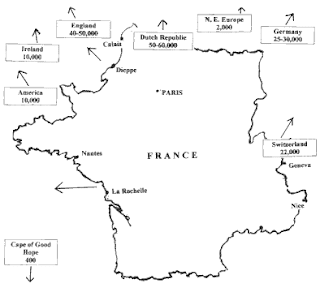Flight of the Huguenots to Ireland
Written by Ben Kesp
Facing prosecution and slaughter for their religious beliefs, thousands of French Protestants were displaced from their country to seek refuge in foreign lands. What became a loss to France became an important gain for other countries. The mass exodus of people left a huge gap within society, creating a brain drain in France. The Huguenots as they were known by the 17th and 18th century prevailed and played vital and pivotal roles in banking, industry, trade, business, armies, science and engineering in their new found lands.
Who were the Huguenots?
The Huguenots were members of the Protestant Reformed Church of France during the 16th and 17th century. The inspiration for the French Protestants was the writings by the Calvinist Movement led by John Calvin in the 1530s. Where the name Huguenot came from is not entirely clear but there are several interpretations for its origins. However by the mid 16th century the protestant class were known as the Huguenots. On fleeing France they reached out to the Protestant nations that would provide them with security and a home like England, Wales, Scotland, Denmark, Sweden, Switzerland, Prussia, Cape Colony in South Africa and the English colonies of North America.
What Happened?
As the number of Protestants grew within France, it caused a reaction from the Catholic Church and State. The Protestants were looked upon as heretics and were to be exterminated. The first reformed church of the Huguenots was established in Paris in 1555 and this only increased the hostility by the French Church. Thirty five years of war were to follow from 1562 when a number of Protestants were killed at Vassy in North Eastern France. During this time many massacres took place and one notable one became known as St. Bartholomew’s Day, where Catholics killed thousands of Huguenots in Paris. These massacres were repeated in major cities and towns across France.
In 1598 the Edict of Nantes ended the religious wars granting French Protestants freedom to practice their religion. However throughout the 1600s the rights and freedom of the Protestants to take up positions in society and practice their faith was decreasing. In 1685 King Louis XIV revoked the Edict of Nantes declaring that all the Huguenot population were to convert to Catholicism in order to remain in France. This led to many Huguenots being captured and enslaved. They fled to Switzerland, Germany, Netherlands, Britain and Ireland. Some Huguenots settlers who fled to Brazil and Fort Caroline (Jacksonville, Florida, US) were not so fortunate facing imprisonment or death at the hands of the Portuguese and Spanish if they did not convert to Catholicism.
Arrival to Ireland
Under an act of parliament around 10,000 Huguenots were encouraged to settle in Ireland at the end of the 17th and early 18th century. Many moved on again to the colonies of North America. Even though their numbers in Ireland were small their impact on the country was significant. They adjusted, flourished and seemed to fit easily into the Irish population taking up positions and creating businesses within society.
At this time the protestant population in Ireland were comprised of the Anglo Irish who were the privileged social group making up the professional and landed class from the 17th century up to the time of Irish independence in the early 20th century. The Huguenots became part of the Irish protestant population but were less socially prominent. Some of them fought for William of Orange in the Williamite wars and were rewarded with grants, titles and lands. They brought many new techniques and skills to Ireland and took up occupations as brewers, map makers, gold smiths, horticulturists, printers, merchants, watch makers, linen makers, engineers, farmers, scientists, musicians, shopkeepers and more.
Many held high positions in society like city and town mayors, architects, bankers, high sheriffs and as Taoiseach (Prime Minister (Seán Lemass - 1959 – 1966)). Other notable Irish Huguenots and descendants are:
- Richard Gandon Architect of the Four Courts and Custom House, Dublin.
- Richard Cassells Designed Leinster House, Powers Court and Carton House.
- La Touche Started Bank of Ireland.
- William Dargan Engineer who constructed Ireland’s first railway line.
- Artists Gabriel Béranger and George Victor Du Noyer.
- Linen Manufacturers Crommelin and De La Cherois Families.
- Writers: Joseph Sheridan Le Fanu, Charles Robert Maturin and Samuel Beckett.
- Oceanographers Mathew Fontaine Maury and Francis Beaufort (Beaufort Scale).
 |
| Powers Court - designed by Richard Cassels |
The Huguenots left their mark on Ireland in many ways and not only did the strange foreign names become as normal sounding as the Irish surnames with many changing their names to fit in with the locals but many streets in cities and towns like D’Olier Street, Dublin City and French Church Lane and Lavitt’s Quay, Cork City now sound as Irish as they are French.
The Huguenot Cross
The cross came into use in the late 17th century after the Edict of Nantes (1598) and there are varied stories of its origin. The cross is made up of four triangles that meet in the centre with eight rounded points signifying the eight beatitudes.
For a people that were forced from their home they left an imprint in many countries around the world. For those who were forced to convert from their faith to remain in France, it was just and only right that in October 1985 President of France, Francois Mitterrand announced a formal apology to the Huguenot descendants around the world. A postage stamp was released at this time honouring the Huguenots that read ‘France is the home of the Huguenots’.
For further information on the Irish and British Society of Huguenots check out their websites at:
The Huguenot Cross
Images: Huguenot National Society and Wikipedia.





Comments
Post a Comment